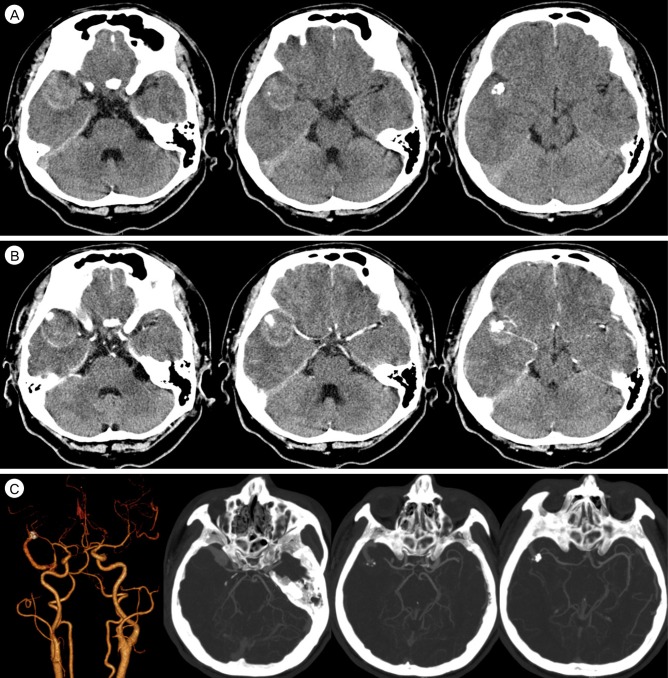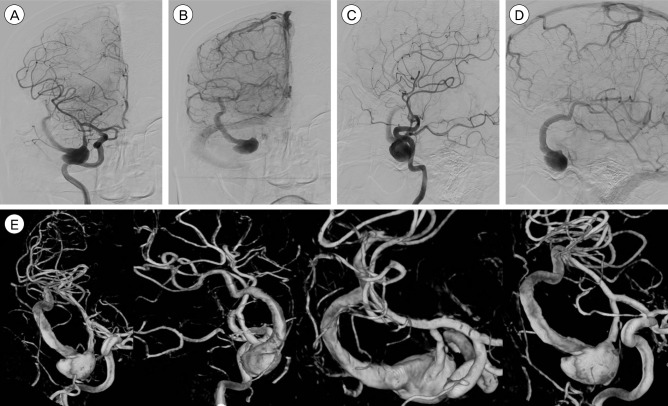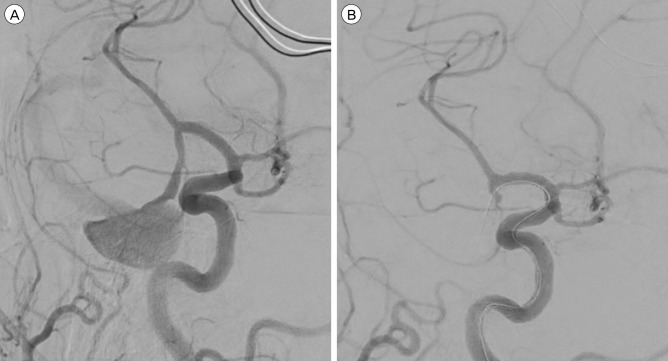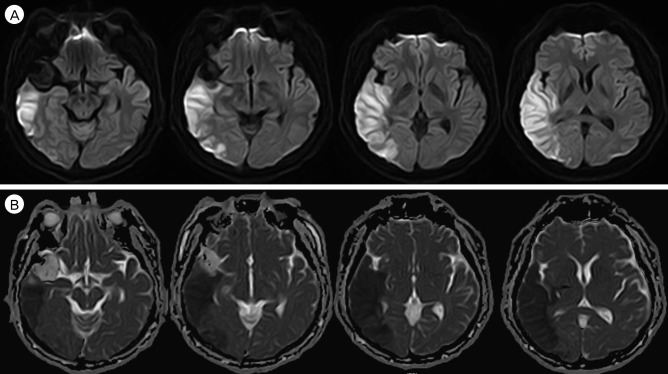J Cerebrovasc Endovasc Neurosurg.
2016 Sep;18(3):264-270. 10.7461/jcen.2016.18.3.264.
Endovascular Treatment of Giant Serpentine Aneurysm of the Middle Cerebral Artery
- Affiliations
-
- 1Department of Neurosurgery, Wonju Severance Christian Hospital, Yonsei University Wonju College of Medicine, Wonju, Korea. jjongse@yonsei.ac.kr
- KMID: 2355652
- DOI: http://doi.org/10.7461/jcen.2016.18.3.264
Abstract
- Giant serpentine aneurysms are uncommon types of aneurysmal disease and have angiographically authentic features. We report a case of a 44-year-old male with headache and seizure. He presented a giant serpentine aneurysm arising from the middle cerebral artery (MCA). It was a large intracranial aneurysm thrombosed as a mass-like lesion while it maintained its outflow drainage into the distal MCA branches. The balloon occlusion test (BOT) was performed to test the tolerance of temporary collateral circulation. Following routine cerebral angiography, we performed an endovascular embolization on the proximal artery of MCA. He was discharged from the hospital with alert mental status and mild Gerstmann syndrome. The short-term follow-up imaging studies showed the decreased mass effect, and the patient presented an improved Gerstmann syndrome. After a careful evaluation of BOT, an endovascular embolization can be one of the powerful therapeutic instruments for giant serpentine aneurysm.
MeSH Terms
Figure
Reference
-
1. Aletich VA, Debrun GM, Monsein LH, Nauta HJ, Spetzler RF. Giant serpentine aneurysms: a review and presentation of five cases. AJNR Am J Neuroradiol. 1995; 5. 16(5):1061–1072. PMID: 7639128.2. Anson JA, Lawton MT, Spetzler RF. Characteristics and surgical treatment of dolichoectatic and fusiform aneurysms. J Neurosurg. 1996; 2. 84(2):185–193. PMID: 8592220.
Article3. Kumabe T, Kaneko U, Ishibashi T, Kaneko K, Uchigasaki S. Two cases of giant serpentine aneurysm. Neurosurgery. 1990; 6. 26(6):1027–1032. discussion 1032-3. PMID: 2362659.
Article4. Lee SJ, Ahn JS, Kwun BD, Kim CJ. Giant serpentine aneurysm of the middle cerebral artery. J Korean Neurosurg Soc. 2010; 8. 48(2):177–180. PMID: 20856671.
Article5. Mahadevan A, Tagore R, Siddappa NB, Santosh V, Yasha TC, Ranga U, et al. Giant serpentine aneurysm of vertebrobasilar artery mimicking dolichoectasia--an unusual complication of pediatric AIDS. Report of a case with review of the literature. Clin Neuropathol. 2008; Jan-Feb. 27(1):37–52. PMID: 18257473.6. Park JS, Lee MS, Kim MS, Kim DJ, Park JW, Whang K. Giant serpentine intracranial aneurysm: a case report. Korean J Radiol. 2001; Jul-Sep. 2(3):179–182. PMID: 11752991.
Article7. Sari A, Kandemir S, Kuzeyli K, Dinc H. Giant serpentine aneurysm with acute spontaneous complete thrombosis. AJNR Am J Neuroradiol. 2006; 4. 27(4):766–768. PMID: 16611761.8. Scott M, Skwarok E. The treatment of cerebral aneurysms by ligation of the common carotid artery. Surg Gynecol Obstet. 1961; 7. 113:54–61. PMID: 13749376.9. Segal HD, McLaurin RL. Giant serpentine aneurysm. Report of two cases. J Neurosurg. 1977; 1. 46(1):115–120. PMID: 830809.10. van Rooij WJ, Sluzewski M, Beute GN. Endovascular treatment of giant serpentine aneurysms. AJNR Am J Neuroradiol. 2008; 8. 29(7):1418–1419. PMID: 18388210.
- Full Text Links
- Actions
-
Cited
- CITED
-
- Close
- Share
- Similar articles
-
- Giant Serpentine Aneurysm of the Middle Cerebral Artery
- Giant Serpentine Intracranial Aneurysm Treated with Wrapping under the Extracorporeal Circulation and Hypothermia
- Giant Serpentine Aneurysm of the Posterior Cerebral Artery: Case Report
- Giant Serpentine Aneurysm of the Anterior Communicating Artery: Case Report
- Endovascular occlusion of giant serpentine aneurysm: A case report and literature review








